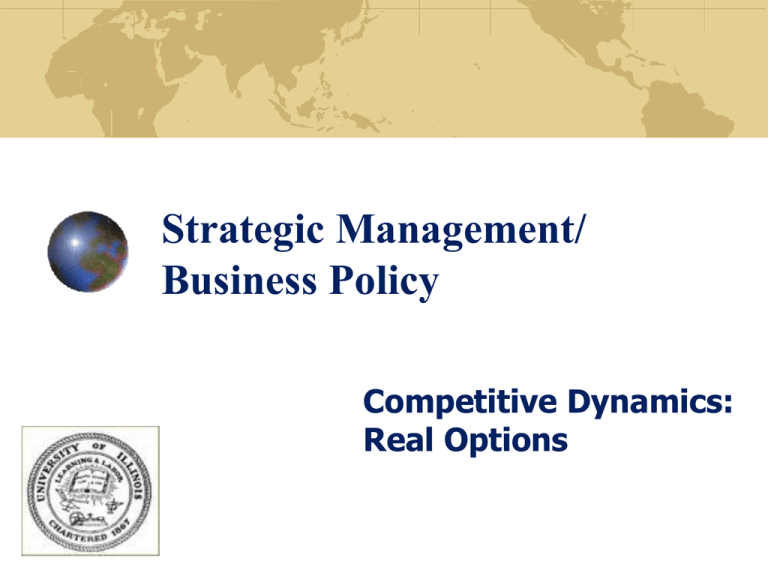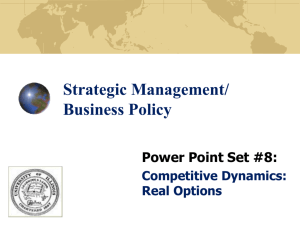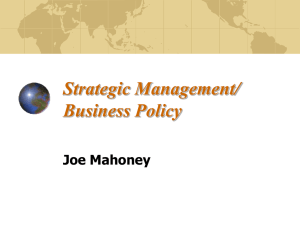10b Competitive Dynamics
advertisement

Strategic Management/ Business Policy Competitive Dynamics: Real Options Competitive Dynamics Competitive dynamics: results from a series of competitive actions and competitive responses among firms competing within a particular industry. Mutual interdependence: results when companies recognize that their strategies are not implemented in isolation from their competitors’ actions & responses. E.g., Coke versus Pepsi Competitive Dynamics A first mover is a firm that takes an initial competitive action. Successful actions allow a firm to earn above-average economic returns until other competitors are able to respond effectively. In addition, first movers have the opportunity to gain customer loyalty. • For instance, Harley-Davidson has been able to maintain a competitive lead in large motorcycles due to intense customer loyalty. Competitive Dynamics A first mover faces potential disadvantages: • High risk; • High development costs; and • High demand uncertainty Competitive Dynamics A “second mover” is a (second, third, fourth, etc.) firm that responds to a first mover’s competitive action often through imitation or a move designed to counter the effects of the initial action. BankOne was a fast second mover in Internet banking. New Balance is a successful second mover in the athletic shoe industry. Competitive Dynamics Second mover advantages include: Reduction in demand uncertainty; Market research to improve satisfying customer needs; Learn from the first mover’s successes and shortcomings; and Gaining time for R&D to develop a superior product Scenario Analysis -The Relationship Between Finance & Strategy Traditional Evaluation Of Financial Projects Traditional Evaluation Of Financial Projects Net Present Value or Discounted Cash Flow Analysis Net Present Value or Discounted Cash CF + Flow Analysis CF + time time - - 3 Basic Factors Determine C/S Market Value 1) Amount of 2) Timing of 3) Risk of Expected cash flows Discounting Cash Flows Horizon Valuet+1 NPV = 1+r + (1+r)2 + (1+r)3 + … + (1+r)t + (1+r)t+1 CF1 CF2 CF3 CFt NPV: Net Present Value CFt: Cash Flow at time t r: Discount rate Horizon Value: Value of ongoing enterprise after time t 22 Scenario Analysis -The Relationship Between Finance & Strategy Differences Between Strategy and Finance: Finance: Payoffs are determined exogenously or by chance Strategy: Our actions affect the economic payoffs we are likely to experience Decision-Theoretic Vs. Game-Theoretic Analysis: • Games against “Nature” Vs. Games against other people 8- 6 How To Handle Uncertainty Sensitivity Analysis - Analysis of the effects of changes in sales, costs, etc. on a project. Scenario Analysis - Project analysis given a particular combination of assumptions. Simulation Analysis - Estimation of the probabilities of different possible outcomes. Break Even Analysis - Analysis of the level of sales (or other variable) at which the company breaks even. Irwin/McGraw-Hill ©The McGraw-Hill Companies, Inc.,2001 Trigeorgis (1997): Real Options A theoretically-accurate NPV analysis should include real options values. The asymmetry deriving from having the right but not the obligation to exercise an option is at the heart of the real options value. Managers making investments under uncertainty can create economic value by building in flexibility, because flexibility has economic value. • Real Options: Managerial Flexibility and Strategy in Resource Allocation Real Options Nucor Steel Mini-mill • Stand-alone investment: NPV = -$50 million – Abandonment Option: High (Low sunk cost) – Growth Option: High (Follow-on investments Commitment Versus Flexibility -The Value of Time Cost to Build Plant = $1600 Cost of Capital = 10% Price(t=1) = $300 Price = $300 .5 Price(t=0) = $200 .5 Price(t=1) = $100 Price = $100 Commitment Versus Flexibility The Value of Time Time Expected Cash Flow (Traditional NPV) Expected Cash Flow (Scenario 1) Expected Cash Flow (Scenario 2) 0 1 2 3 4 5 6 7 8 Infinity $ $ $ $ $ $ $ $ $ $ (1,400) 200 200 200 200 200 200 200 200 200 $ $ $ $ $ $ $ $ $ $ (1,300) 300 300 300 300 300 300 300 300 $ $ $ $ $ $ $ $ $ $ (1,500) 100 100 100 100 100 100 100 100 NPV $ 600 $ 1,545 $ (455) Build now (classic NPV) versus value of waiting NPV calculation ($1400) in year 0 .5($300) + .5($100) = $200 for each year after Value of $200 perpetuity=$2000 Expected NPV ($1400) + $2000=$600 Waiting Year 0 = $0 Scenario 1 (price = $300) Scenario 2 (price = $100) Yr. 1=($1300) Perpetuity of $300 NPV =$1545 Yr. 1=($1500) Perpetuity of $100 NPV =($455) NPV of waiting: .5($1545) + .5(0) = $773 Value of waiting one period Expected value of building the plant in period 0 = $600 If the firm waits a year, the uncertainty is resolved, and the firm will undertake the investment only if the price is $300 By waiting a year, the firm’s expected value is (1545*0.5 + 0* 0.5) =$773, as opposed to $600 Value of the option = 773 – 600 = $173 Competencies and Strategic Flexibility Strategic flexibility is analogous to “having options” and commitment is analogous to the “exercise of an option.” The greater the uncertainty the firm faces, the more valuable are its real options. The resolution of uncertainty over time is the catalyst which induces a manager to make (sunk cost) commitments.






